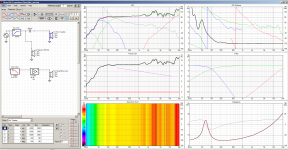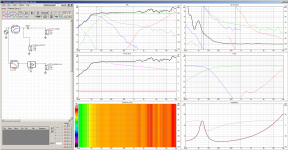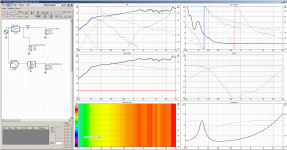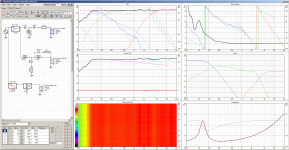I got curious and decided to download the dayton frd and zma files and traced the tang band and hivi response and impedance.
Put the whole thing into vituix cad and below is the result. Note that I have not adjusted any of the manufacturer curves for bafflestep so this is not a particularly realistic sim and in fact I would expect the bass to be lower than what it shows.
The tweeter is having more of an effect that I anticipated, but I wouldn't necessarily call it positive It does smooth out some dips to a degree but accentuates the peaks as well.
It does smooth out some dips to a degree but accentuates the peaks as well.
The (unadjusted) curves for the tang band and the dayton do actually blend quite well using the 12db / octave LP on the woofer at 100Hz and the 6db / octave HP on the dayton/hivi, so I think the issue is with the large variations above 3Khz.
I've attached a zip file with the frd's and vituixcad project file. Vituixcad can be downloaded here Software
Note if you extract to c:\ it will create folders c:\speakers\dina and the project file will load and all will work properly. If you want to put it elsewhere you will need to edit the dina_sim.vxp project file and change all instances of c:\speakers\dina\ with whatever the new path is.
To do a proper crossover model for tweeter to mid baffle step compensation (based on the dimentions of the box) should be incorporated.
edit: I've not put in any of the speaker offsets either which also should be present. This was a quick and dirty sim to get a rough idea of how the speaker was working.
Tony.
Put the whole thing into vituix cad and below is the result. Note that I have not adjusted any of the manufacturer curves for bafflestep so this is not a particularly realistic sim and in fact I would expect the bass to be lower than what it shows.
The tweeter is having more of an effect that I anticipated, but I wouldn't necessarily call it positive
The (unadjusted) curves for the tang band and the dayton do actually blend quite well using the 12db / octave LP on the woofer at 100Hz and the 6db / octave HP on the dayton/hivi, so I think the issue is with the large variations above 3Khz.
I've attached a zip file with the frd's and vituixcad project file. Vituixcad can be downloaded here Software
Note if you extract to c:\ it will create folders c:\speakers\dina and the project file will load and all will work properly. If you want to put it elsewhere you will need to edit the dina_sim.vxp project file and change all instances of c:\speakers\dina\ with whatever the new path is.
To do a proper crossover model for tweeter to mid baffle step compensation (based on the dimentions of the box) should be incorporated.
edit: I've not put in any of the speaker offsets either which also should be present. This was a quick and dirty sim to get a rough idea of how the speaker was working.
Tony.
Attachments
Last edited:
@wintermute rite on man, this is way more then I thought. I ordered new plate amps to come in Tuesday and am going to wire it up and see what it sounds like after tweeking some things. Will upload some pics and or video and let you know the outcome. Thanks a ton for the info, i might just go the route of cross overs any way. Just ordered the Marantz 5013 to start a new system .
OK so a new upload of the SIM. I fixed the tweeter impedance, and since I already had all the frd's decided to do the baffle step (using vituix cad) and see how it looked with that, then I decided to do a passive network to cut the tweeter in at a more reasonable point. I also found that the downloaded dayton frd's and zma's weren't minimum phase, so fixed that.
This was an academic exercise to see what may be a possible improvement on the design. As it is using the manufacturers curves I wouldn't put too much weight on it, but it would probably be a good starting point, especially if you could get some good measurements of the drivers in the box. The biggest difference is likely to be the tweeters response on the box, as I can't sim the diffraction effects it will likely be subject to.
I looked at a youtube video from the designer, and the tweeter in the as designed position is supposed to be time aligned, so I put no Z offest in the sim. I took a guess for the tweeters vertical offset (it makes only a small difference to the sim).
I'm not very good at 2nd order crossovers, so I have gone with a 4th order acoustic L/R at 3Khz with 84db target level. This does reduce the sensitivity a bit, but I suspect it would be more balanced. I think it equates to between 3 and 4db of baffle step compensation. For the sub I increased the gain 5db (i think the plate amp can do 6db boost on the sub.
The phase matching isn't fantastic, but they aren't real measurements so there was no point in going for perfection. Obviously this is a much more complicated crossover than the single cap, but I suspect something like this would make a pretty big difference to how the speakers sound.
As I said before, 4K may be a better crossover point for the tweeter, but 3K is probably better for the dayton...
So the new sim is attached, same as before but now has corrected (hopefully) frd and zma files and also three sims. The original dina_sim, dina_sim_bs (with baffle step corrected sub and mid) and dina_sim2 (4th order L/R at 3Khz) Note that the FIR block to simulate the 100Hz HP in the plate amp turns off the real impedance of the network, you can see it by temporarily shorting the FIR block.
Anyway I had some fun with this, hope it is at least a bit educational
Oh and one other thing. Since the plate amp has speaker outputs, you could always put some binding posts on the back of the box and run a wire from the plate amp output to the binding posts and avoid having to solder to the connections on the amp board. Little more hardware, but hopefully safer!
Tony.
This was an academic exercise to see what may be a possible improvement on the design. As it is using the manufacturers curves I wouldn't put too much weight on it, but it would probably be a good starting point, especially if you could get some good measurements of the drivers in the box. The biggest difference is likely to be the tweeters response on the box, as I can't sim the diffraction effects it will likely be subject to.
I looked at a youtube video from the designer, and the tweeter in the as designed position is supposed to be time aligned, so I put no Z offest in the sim. I took a guess for the tweeters vertical offset (it makes only a small difference to the sim).
I'm not very good at 2nd order crossovers, so I have gone with a 4th order acoustic L/R at 3Khz with 84db target level. This does reduce the sensitivity a bit, but I suspect it would be more balanced. I think it equates to between 3 and 4db of baffle step compensation. For the sub I increased the gain 5db (i think the plate amp can do 6db boost on the sub.
The phase matching isn't fantastic, but they aren't real measurements so there was no point in going for perfection. Obviously this is a much more complicated crossover than the single cap, but I suspect something like this would make a pretty big difference to how the speakers sound.
As I said before, 4K may be a better crossover point for the tweeter, but 3K is probably better for the dayton...
So the new sim is attached, same as before but now has corrected (hopefully) frd and zma files and also three sims. The original dina_sim, dina_sim_bs (with baffle step corrected sub and mid) and dina_sim2 (4th order L/R at 3Khz) Note that the FIR block to simulate the 100Hz HP in the plate amp turns off the real impedance of the network, you can see it by temporarily shorting the FIR block.
Anyway I had some fun with this, hope it is at least a bit educational
Oh and one other thing. Since the plate amp has speaker outputs, you could always put some binding posts on the back of the box and run a wire from the plate amp output to the binding posts and avoid having to solder to the connections on the amp board. Little more hardware, but hopefully safer!
Tony.
Attachments
Winter, I ended up putting binding posts on and running them that way. Went a bought a Suca mini pre amp and ran them on the front pre out of my manantz 5013 which I picked up and bought a rsl sub. Once I got all of that hooked up and messed around with the crossovers on the reciver they have great clarity . Was super surprised , rand through a bunch of audiophiles on Spotify .
Saving up for some harbeth or buchardt bookshelf speakers next, And looking into a better tube amp set up . I may try to find another solution for a Diy bookshelf speaker for this summer , I get bored really easy and working hands on with anything is always fun. Any suggestions on plans and drivers?
Hello Winter and Fee,
I'm new to this diy game and I've been looking at these speakers as my first build. I found this thread searching for what Fee was originally trying to do which is build a crossover and forego the plate amps. Now that you've run these for a while, which way would you setout to do from the start Fee? I'd much prefer to run a separate amp.
Of course, I'm open to being persuaded away from building these and making something a bit more appropriate for a first timer. I'd love to hear suggestions.
I appreciate any advice you've got time to share.
Cheers,
Will
I'm new to this diy game and I've been looking at these speakers as my first build. I found this thread searching for what Fee was originally trying to do which is build a crossover and forego the plate amps. Now that you've run these for a while, which way would you setout to do from the start Fee? I'd much prefer to run a separate amp.
Of course, I'm open to being persuaded away from building these and making something a bit more appropriate for a first timer. I'd love to hear suggestions.
I appreciate any advice you've got time to share.
Cheers,
Will
FWIW, I don't think the plans for these 'Dinas' are even worth $20.
I've thought about doing this before with a 2.1 plate amp, but having the same input going to each of left and right input, and then having a valid passive xover on the inside. The reason I would do this is to bi-amp the woofer and get more output potential.
I just think this is poorly executed, and to even be a bit blunt, Nick really is pretty green when it comes to xover design.
I would look elsewhere,
Wolf
I've thought about doing this before with a 2.1 plate amp, but having the same input going to each of left and right input, and then having a valid passive xover on the inside. The reason I would do this is to bi-amp the woofer and get more output potential.
I just think this is poorly executed, and to even be a bit blunt, Nick really is pretty green when it comes to xover design.
I would look elsewhere,
Wolf
Yes I'd avoid the Dinas, unless you are willing to completely redo the design of the crossover. Fee's experience should be a warning. The tweeter was little more than cosmetic.
I don't know what your budget is, if you want something small I've heard good comments about Jeff Bagby's picolos. Also a lot of people go for various Paul Carmody designs as first projects.
Tony.
I don't know what your budget is, if you want something small I've heard good comments about Jeff Bagby's picolos. Also a lot of people go for various Paul Carmody designs as first projects.
Tony.
Thank you Tony and Wolf
I think I'll pass on the DINAS. Originally i wanted to build them with a redesigned xo, but after learning more and listening to your advice, I've settled on starting with a 2-way design. Which one is still up in the air. I grew up doing woodwork but haven't run a table saw in a very long time. So I'm starting from scratch. I have no tools yet and very little knowledge. So...
I've been reading your series, 'so you want to build your own speakers from scratch' and i can't thank you enough for the detailed process and wealth of information. At this point I'm trying to learn all the acronyms, driver details and design reasoning.
I'll check out the recommendations you make regarding first time builds. I've set a goal of having my first set completed by February 1st.
Thanks again
I think I'll pass on the DINAS. Originally i wanted to build them with a redesigned xo, but after learning more and listening to your advice, I've settled on starting with a 2-way design. Which one is still up in the air. I grew up doing woodwork but haven't run a table saw in a very long time. So I'm starting from scratch. I have no tools yet and very little knowledge. So...
I've been reading your series, 'so you want to build your own speakers from scratch' and i can't thank you enough for the detailed process and wealth of information. At this point I'm trying to learn all the acronyms, driver details and design reasoning.
I'll check out the recommendations you make regarding first time builds. I've set a goal of having my first set completed by February 1st.
Thanks again
Hello again.
It's been a while. Since I first asked for your advice, I've ventured down the rabbit hole with no end in sight.
Here's what I've done.
First, I decided to design and build my own speakers from 'scratch'. I dug into various designs, decided on a size, designed the xo and box using software, purchased the drivers and crossover parts from PE. I bought a bunch of tools, emptied a bedroom and got to work on the boxes. Cut, glued and painted, I then soldered them together, wired them up and hooked them up to a Fosi BT20A and was pleasantly surprised at what I'd done. Great experience but, I wanted to go deeper.
So, I bought the Continuum II and baby boomer kit from Meniscus. Got Baltic ply for the cabinets, spent a great deal of time on the wood, built the sub box, built an entertainment center, bought a record player and a Emotiva TA-100 and a couple dozen records, repurposed an old all-in-one computer for a media center and hung my TV on the wall.
From watching a video on the DINAS, to learning how to make square(ish) boxes, design an xo, finish wood, and finally, really experience great sound, this has been a fantastic experience.
Now, I'm working up to building a proper tube amp by assembling a Douk Audio one for 'practice'.
Just thought I'd share. Thanks again for your advice early on. It helped.
Will in Korea
DIY - Google Photos
It's been a while. Since I first asked for your advice, I've ventured down the rabbit hole with no end in sight.
Here's what I've done.
First, I decided to design and build my own speakers from 'scratch'. I dug into various designs, decided on a size, designed the xo and box using software, purchased the drivers and crossover parts from PE. I bought a bunch of tools, emptied a bedroom and got to work on the boxes. Cut, glued and painted, I then soldered them together, wired them up and hooked them up to a Fosi BT20A and was pleasantly surprised at what I'd done. Great experience but, I wanted to go deeper.
So, I bought the Continuum II and baby boomer kit from Meniscus. Got Baltic ply for the cabinets, spent a great deal of time on the wood, built the sub box, built an entertainment center, bought a record player and a Emotiva TA-100 and a couple dozen records, repurposed an old all-in-one computer for a media center and hung my TV on the wall.
From watching a video on the DINAS, to learning how to make square(ish) boxes, design an xo, finish wood, and finally, really experience great sound, this has been a fantastic experience.
Now, I'm working up to building a proper tube amp by assembling a Douk Audio one for 'practice'.
Just thought I'd share. Thanks again for your advice early on. It helped.
Will in Korea
DIY - Google Photos
- Home
- Loudspeakers
- Multi-Way
- Bookshelf speaker crossovers




